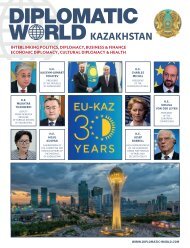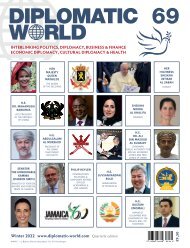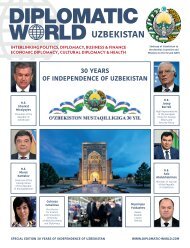Diplomatic World 67
You also want an ePaper? Increase the reach of your titles
YUMPU automatically turns print PDFs into web optimized ePapers that Google loves.
H.E. TSHERING GYALTSHEN PENJOR<br />
AMBASSADOR OF BHUTAN<br />
TO THE KINGDOM OF BELGIUM<br />
AND THE EUROPEAN UNION<br />
UNLIKE MOST COUNTRIES THAT USE THE GROSS<br />
DOMESTIC PRODUCT INDEX TO MEASURE<br />
DEVELOPMENT, BHUTAN USED THE GROSS<br />
NATIONAL HAPPINESS INDEX. IN A GLOBAL<br />
SOCIETY OBSESSED WITH ECONOMIC MEAS-<br />
URES, THIS MODEL PROVIDES A REVOLUTIONARY<br />
AND HOLISTIC UNDERSTANDING OF DEVEL-<br />
OPMENT. HOW HAS THIS MEASURE OF GROSS<br />
NATIONAL HAPPINESS HELPED BHUTAN IMPROVE<br />
ITS ECONOMIC, ENVIRONMENTAL AND SOCIAL<br />
CONDITIONS?<br />
we are set to graduate to a lower-Middle Income Country in<br />
2023. We have more than halved our poverty rates since<br />
2007 and the 2020 UNDP Human Development Report ranks<br />
Bhutan highest amongst the Least Developed Countries on<br />
overall human development. Our constitution mandates us to<br />
maintain 60 percent of the country under forest cover for all<br />
times to come. We currently have a total forest cover of 72.5<br />
percent and we are one of the only carbon negative countries<br />
in the world today, meaning that we sequester more greenhouse<br />
gases than we ever release. Our ‘high value, low volume’<br />
sustainable tourism policy has also helped our economy while<br />
making sure that the negative impact from the tourism sector on<br />
The term Gross National Happiness (GNH) was promulgated by<br />
our environment and communities remain as low as possible. All<br />
His Majesty the Fourth King of Bhutan Jigme Singye Wangchuck<br />
these improvements in the social, economic and environmental<br />
in 1972 when he said that “Gross National Happiness is more<br />
spheres are due to the conscious policy decisions made under<br />
important than Gross Domestic Product.” Since then, all socio-<br />
the overarching philosophy of GNH.<br />
economic policies and programs in Bhutan have been guided by<br />
the philosophy of GNH. Through the GNH Index, Bhutan aimed<br />
to create a measurement or screening tool that would be useful<br />
for policy making and hence give rise to a conducive environment<br />
for all to maximize happiness. The GNH index includes four<br />
pillars viz. good governance, sustainable socio-economic development,<br />
cultural preservation and environmental conservation.<br />
Furthermore, the four pillars are classified into nine domains viz.<br />
IN ITS 12TH FIVE YEAR PLAN (2018-2023), WHICH<br />
WILL PAVE THE WAY FOR THE COUNTRY’S GRAD-<br />
UATION FROM LDC STATUS, BHUTAN IS PAYING<br />
CLOSE ATTENTION TO THE 2030 SUSTAINABLE<br />
DEVELOPMENT AGENDA. WHAT STEPS IS<br />
BHUTAN TAKING TO INTEGRATE AND MAIN-<br />
STREAM THE 2030 SUSTAINABLE DEVELOPMENT<br />
GOALS INTO ITS NATIONAL STRATEGY AND<br />
POLICIES? IS BHUTAN ON COURSE TO ACHIEVE<br />
THESE OBJECTIVES?<br />
use, cultural diversity and resilience, and community vitality. The<br />
17 NKRAs are therefore closely aligned to the SDGs and their<br />
targets and indicators are integrated into the 12th FYP. Bhutan<br />
presented its second Voluntary National Review Report on the<br />
implementation of the 2030 Sustainable Development Agenda in<br />
September 2021.<br />
psychological well-being, health, education, time use, cultural<br />
In Bhutan, we follow a planned five-year socio-economic devel-<br />
diversity and resilience, good governance, community vitality,<br />
opment program (FYP) which charts out the development agen-<br />
When Bhutan undertook its first Voluntary National Review in<br />
ecological diversity and resilience and living standards. These<br />
da of the Government for a five-year period. The FYP coincides<br />
2018, all SDGs except for SDG 17 were reported to be on track.<br />
nine domains further cascade down into 33 indicators that aim<br />
with the tenure of the elected Government which also lasts for<br />
However, given the impact of the COVID-19 pandemic, the<br />
to capture the different aspects of well-being. The philosophy<br />
five years. The 12th FYP commenced from 1st November 2018<br />
achievement of several SDGs are reported to be at risk today<br />
of GNH functions on the basis that humans need more than just<br />
and will end on 31st October 2023. It has 17 National Key Result<br />
particularly SDGs 1,4,8,10 and 17. Impacts across other SDGs<br />
material wealth to pursue a productive life; it gives equal empha-<br />
Areas (NKRAs) and takes into consideration the SDGs and other<br />
have also been evident. While Bhutan has done well in terms of<br />
sis to other non-material indicators such as spiritual, cultural and<br />
regional and international commitments. Hence, all goals such<br />
containing the spread of the pandemic and in keeping infection<br />
environmental needs.<br />
as the Sustainable Development Goals (SDGs) are mainstreamed<br />
levels low, the implementation of pandemic containment meas-<br />
into the respective FYP development programs. Moreover, all<br />
ures has had far reaching impacts on the overall socio-economic<br />
The GNH Policy Screening Tool implemented by the Gross<br />
development policies and programs are guided by the overarch-<br />
growth, with economic growth being revised to negative 6.1<br />
National Happiness Commission makes sure that all government<br />
ing philosophy of GNH. There is a strong resemblance between<br />
percent in December 2020 from a growth projection of<br />
projects and policies complement each other thereby maximizing<br />
the domains of GNH and the SDGs. The SDGs call for pursuing<br />
6.9 percent for 2020.<br />
GNH. Guided by the philosophy of GNH, Bhutan has consider-<br />
development through a balanced approach on social, econom-<br />
ably improved its economic, environmental, social and governance<br />
situation in the past four decades. We have recorded an<br />
average growth rate of 7.5 percent since the early 1980s and<br />
ic and environmental conditions. Similarly, the development<br />
philosophy of GNH focuses on these three aspects as well as<br />
on the other aspects such as psychological well-being, time<br />
BHUTAN HAS MADE INTERNATIONAL HEADLINES<br />
BY BECOMING THE WORLD’S FIRST CARBON<br />
54 55

















